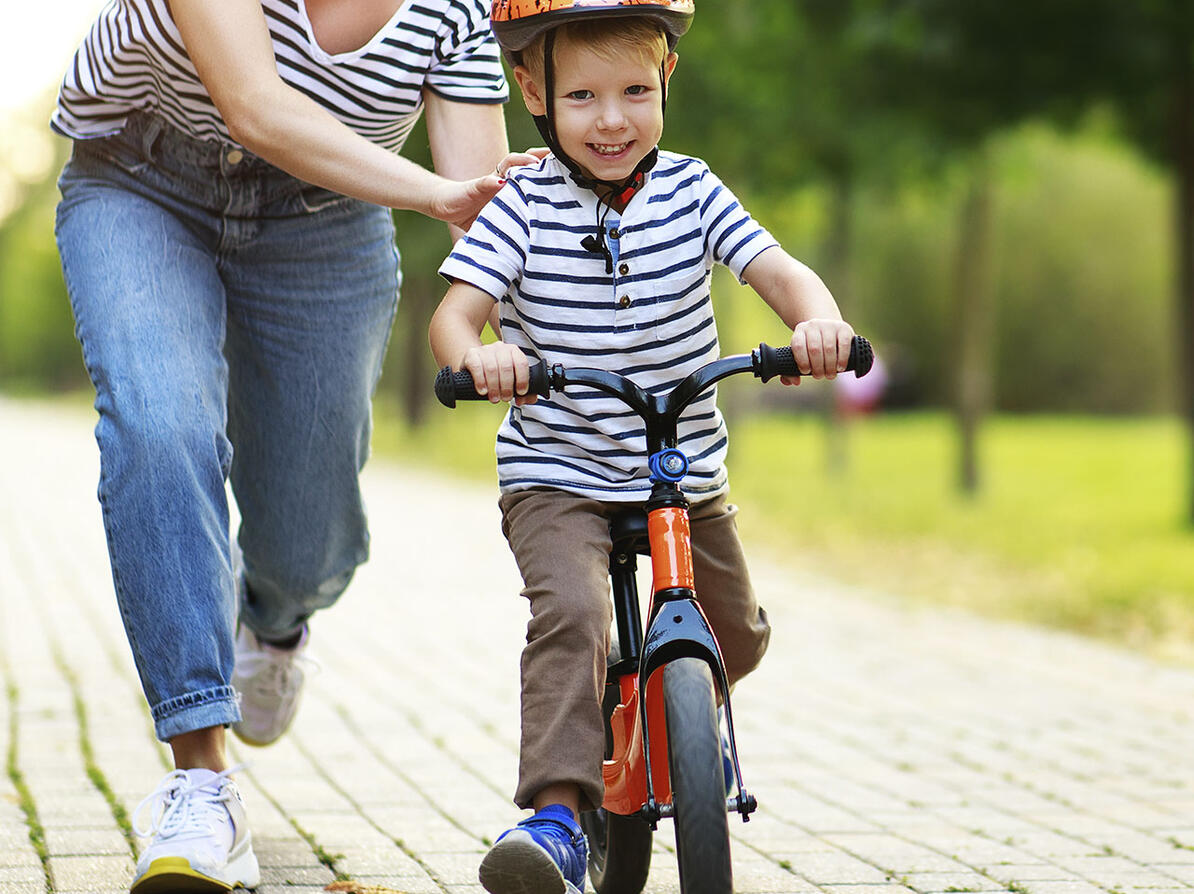Test: Running bikes
Does running bikes contain unwanted chemicals? The Danish Consumer Council THINK Chemicals have tested the toys for suspected endocrine disruptors and carcinogens in handlebars, saddles and tires.

Running bikes are a popular type of toy where your child can train their balance and be prepared to ride a bike.
However, running bikes - or balance bikes as they are also called - can contain a number of unwanted chemicals in the handlebars, saddle or tires.
Children are exposed to these parts of the bikes and therefore they should be free of unwanted chemicals.
Many unwanted substances are banned in toys
There are rules for a number of problematic substances such as phthalates, flame-retardants and certain PAHs in toys.
Four types of phthalates (DEHP, DBP, DIBP and BBP) are banned in toys in the EU because they are endocrine disruptors. A number of other phthalates are also suspected of being endocrine disruptors.
Flame retardants and PAHs are or are suspected to be carcinogenic.
These unwanted substances are in running bikes
In the test, 10 out of 12 running bikes contain flame retardants, phthalates or PAHs in the handlebars, saddle or tires.
In eight of the running bikes, the content of one or more of the substances is in concentrations above allowed limits in toys in Denmark.
The eight running bikes contain either substances not allowed in toys at all or substances not allowed in toys for children under the age of three, where special rules apply.
The last two running bikes contain other problematic PAHs in concentrations above German guidelines. These are not prohibited in toys. However, due to the suspicion of increased cancer risk, they are still undesirable in toys.
Companies remove the products
Many running bikes from the test are now removed from the Danish market.
Some companies also offer tire and saddle replacements or return of affected bikes.
Some do not recognize test results
Only a few companies do not immediately recognize the test results because their own tests show otherwise.
Thus, they will first investigate further before deciding what to do.
The Danish Consumer Council THINK Chemicals: Unheard of problems with chemicals in running bikes
"We have previously tested running bikes in 2013, where we also saw a lot of problems with the content of unwanted chemicals in the products. The picture has clearly not improved. On the contrary. We still find flame retardants, phthalates and this time also PAHs in many of the running bikes. In many cases above the level allowed in toys. Only 2 of the 12 running bikes are without problematic content. It is not okay. There is a need for companies to make sure to avoid the problematic chemicals in all parts of the bikes. We would also urge the authorities to check more of this type of product. "
Claus Jørgensen, Project Manager, the Danish Consumer Council THINK Chemicals
About the test
-
The Danish Consumer Council THINK Chemicals has in colaboration with the German consumer organization Stiftung Warentest tested 12 running bikes to be used by children aged two to five years.
There are both running bikes made of wood, plastic and metal, as well as running bikes with point-free plastic tires and air-filled rubber wheels.
We have examined the content of chemicals in the handlebars, saddle and tires, as these are parts all children meet for a shorter or longer period.
We have investigated these substances for:
- PAHs, which can be carcinogenic.
- Phthalates suspected of being endocrine disruptors.
- Phosphorus-containing flame retardants suspected of being endocrine disruptors and carcinogens.
- Chlorinated paraffins suspected to be endocrine disrupting and carcinogenic.
We have only investigated whether the substances are recorded in the products. We have not tested to what extent the substances are released from the products.
What we found
The Overall result from the test:
Two running bikes get the best chemical rating, the A-rating. They are either completely free of unwanted chemicals or contain only small traces of a single substance.
10 running bikes get the lowest chemical rating, the C-rating. They contain large amounts of problematic chemicals, such as PAHs, phthalates or flame retardants. In several cases, the content is above the limits of toys.
Phthalates:
Four of the strollers tested contain phthalates.
Phthalates are or are suspected to be endocrine disruptors.
- In a running bike, Trybike, we found DEHP in the saddle.
- Another running bike, the Lionelo, contained DBP in the tires.
- In both cases, the content of the phthalates in question was above the level allowed in toys in the EU.
- Three running bikes contained DPHP in the saddle.
In Denmark, there has been a ban on all phthalates, including DPHP, in toys intended for children under the age of three since 1999. The contents of all three saddles were above the set limit.
Most of the tested running bikes are marketed and suitable for children under three years. This also applies to the three running bikes with DPHP in the saddle.
PAHs:
PAHs are found in large quantities in six of the 12 running bikes tested.
PAHs are a group of substances in which many of the substances are or are suspected to be carcinogenic.
The EU has a limit value for selected PAHs in toys and consumer products that you are contact with on a long-term basis.
In all six running bikes, it was in the tires the test showed the content of the unwanted substances.
The test shows that the tires on four of the running bikes contain i.a. benzo (a) anthracene, chrysene, benzo (b + j) fluoranthene, benzo (k) fluoranthene, benzo (j) fluoranthene and benz (e) pyrene in concentrations above the EU limit for toys.
The tires on two other running bikes contain another PAH (benz (ghi) perylene) in concentrations above the German guidelines that apply to the GS mark for toys with short-term skin contact.
In the handlebars of one of the running bikes, the test also shows the content of the PAH naphthalene.
Naphthalene is not banned in toys, but the substance is classified in the EU as a possible carcinogen. The content is above the German guidelines that apply to the GS brand for toys.
Flame retardants:
One of the tested running bikes, Puky LR M, contains the flame retardant TCPP in the saddle.
Three phosphorus-containing flame retardants (TCEP, TCPP and TDCP) are banned in the EU in toys for children under the age of three at concentrations above 5 mg / kg because they are suspected of being carcinogenic.
Most of the running bikes are intended for children under the age of three, including the Puky running bike with TCPP.
-
The companies behind the running bikes have all sent comments in connection to the tests. Many of the tested running bikes are removed from the Danish market, or change of tires, saddle or return of the bikes has been offered.
Some companies do not immediately recognize the test results, as their own tests show otherwise. They will first investigate the matter further before deciding what to do.
Here are the individual companies' comments:Puky
"Child safety is our highest priority. Unfortunately, tests have shown that some of our running bike saddles exceed the limit value of a flame retardant for toys, for children under 3 years. Running bikes with black saddles purchased during 2021 may be affected. This is extremely unfortunate, and has of course already been addressed in production. A toxicological report, which we ordered immediately, afterwards, has shown that even under the most unfavorable conditions there is no health risk to children when they use the saddle normally. Even under prolonged and direct skin contact, the flame retardant could not be "detached" from the saddles. Having said that, we have of course decided to offer replacement of the affected saddles.
On www.puky.de/dk/sadler you can check whether a specific product is covered.
We will send a new saddle immediately, if it is a saddle affected by the problem.”Pinolino balance bike Johann
Import for Kids, which was a distributor of Pinolino in Denmark, states that they no longer distribute the running bike. They have only sold very few Pinolino running bikes to Scandinavian consumers.
Trybike
Co & Co bv, which produces Trybike, is surprised by the results of the test made by the Danish Consumer Council. The company performs an annual test of the saddles and every two years a test of the entire bike, to ensure that safety and quality are in order. Both saddle and bike have passed all tests each time. Since the Danish Consumer Council's test, Co & Co bv has once again tested the saddle at an independent test center - a test the saddle once again passed.
Co & Co bv states that they examine the test results from the Danish Consumer Council closely to find the reason for the result.
They say their goal has always been, and still is, to design and produce safe toys for children.Kinderkraft
Pixizoo sells the running bike from Kinderkraft.
They state that they have returned the Uniq running bikes to the supplier and asked them to make sure their other running bikes do not contain too high concentrations. The supplier had tested the product before, but suspected the mistake might had happened in a lot.Bikestar
Bikestar states that they will offer all consumers who have purchased a Bikestar Magnesium running bike to have their tires replaced.
Euroskateshop, which is a dealer of Bikestar in Denmark, states that they have stopped selling the Bikestar running bike, and as far as possible, they will contact the customers who have bought the running bike from them.
KokuaKokua in Denmark states that they are awaiting Kokua's further examination of the tires. They will follow up on the matter thereafter.
Lionelo
Babymarkt, which is responsible for the Lionelo Bart running bike in Denmark, states that they have removed the running bike from their range.
Janod
Janod states that they have previously tested the running bike in accordance with current EU regulations to ensure that it complies with the rules and is safe. They are now looking at whether to carry out further testing of a running bike from their warehouse.
My Hood Rider
Euro Play, which is responsible for the My Hood Rider running bike in Denmark, will in future change to other tires that do not contain too high levels of PAHs. At the same time, Euro Play offers customers who have purchased a My Hood Rider that they can return it and get their money back.
Micro Mobility
Europlay is an importer of the Micro running bike in Denmark and states that Micro Mobility has previously tested and found that their running bike complies with the rules. Micro Mobility does not believe that the chemicals tested are relevant to current standards. However, they will look into it and have further tests performed.
